Looking for the perfect Northern Territory road trip itinerary? This guide to the Top End has you covered.
Planning a journey through the Northern Territory’s Top End might sound a bit intimidating at first. But it’s one of the best – and easiest – Australian road trips to plan.
From the stunning wildlife and culture of Kakadu National Park to the refreshing swimming holes of Katherine and Litchfield, I’ve navigated these rugged roads myself and have come up with what I think is the perfect itinerary to see this part of Australia in a short amount of time.
This trip hits Australia’s most interesting capital city plus three amazing national parks.
As part of my recent half-lap of Australia, I took this exact road trip – although I have adapted it for those who may not have as much time as we did. Here’s everything you need to know about road tripping Australia’s Top End, including the useful travel tips I gathered along the way.
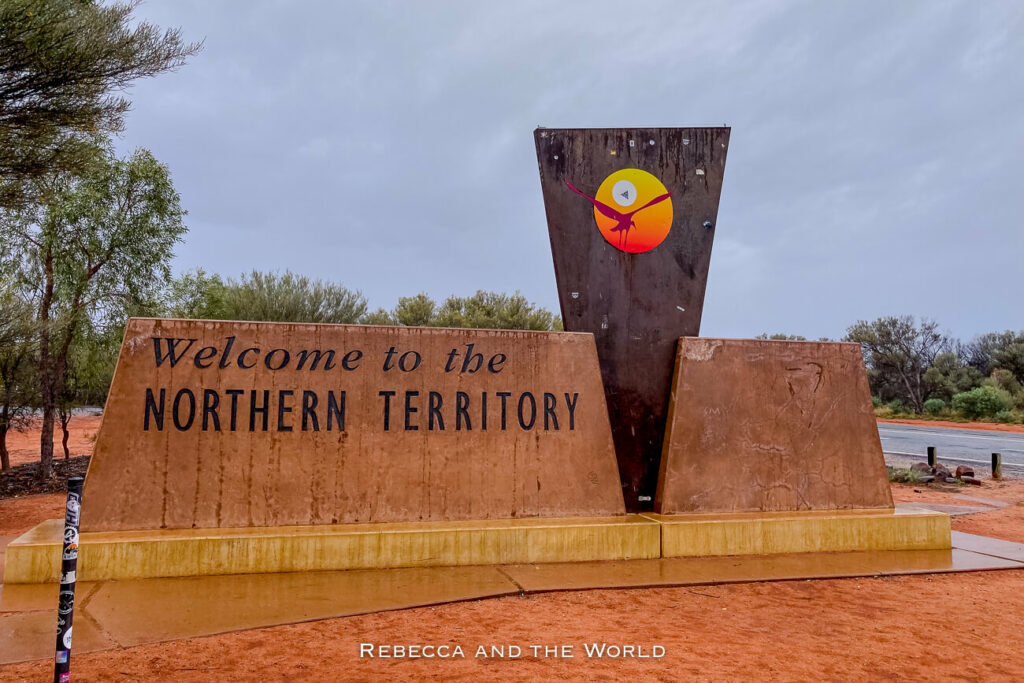
This blog post may contain affiliate links, meaning if you book or buy something through one of these links, I may earn a small commission (at no extra cost to you).
How many days for a Northern Territory road trip?
You can do this Top End road trip in a week but I recommend at least 10 days to really enjoy the experience.
Northern Territory road trip itinerary
One of the best road trips in Australia, here’s what this itinerary looks like over 10 days:
- Days 1-2: Darwin
- Days 3-5: Kakadu National Park
- Days 6-7: Katherine
- Days 8-9: Litchfield National Park
- Day 10: Back to Darwin
Northern Territory map
How to do this NT trip
Should you take a tour of the Top End or self-drive? Obviously I think driving the route yourself is the best way. You’ll be able to stop where you want and plan your schedule around the time you have available.
I know it can seem daunting to road trip the NT, but it’s really easy to do.
Rent a car in Darwin, if you don’t have your own wheels. You don’t need a 4WD – a 2WD is fine as all the main roads are sealed. However, if you want to get off the beaten path in some of the national parks, a 4WD will allow that.
I recommend renting a campervan or motorhome so you have your accommodation on wheels! This is the most fun way to see this part of the NT. Motorhome Republic has a huge range of campers as well as cars with rooftop tents.
For accommodation along the way, you can book hotels or cabins or campsites. I’ve suggested accommodation options for all types of travel for each of the stops outlined.
Days 1-2: Darwin
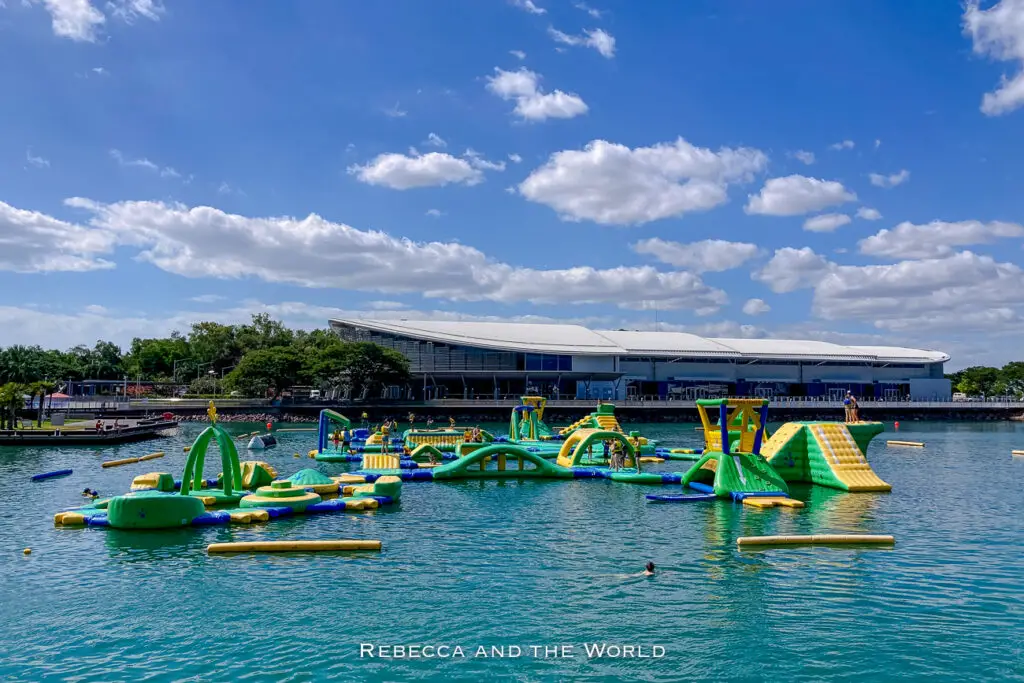
Darwin is one of the most interesting capital cities in Australia. It’s quite unlike anywhere else in Australia and worth a few days of your time.
Arrive in Darwin and pick up your rental car or campervan.
I have a full guide to the best things to do in Darwin, and a must-do is the city’s famous markets. If you can, time your arrival in Darwin with one of them.
The Mindil Beach Market is the most popular Darwin market. Held Thursday and Sunday evenings during the dry season, the market has everything from food, clothing, jewellery, art and more. The food here is a mix of Asian cuisines – Darwin is closer to Bali than Sydney – as well as deep-fried crocodile and delicious desserts. Make sure you head over to the beach to take in the stunning sunset.
The other markets I recommend are the Parap Market (Saturday) for even more amazing food, and the Rapid Creek Market (Saturday and Sunday), which is where many Darwin locals come to buy their fresh produce.
Take a stroll through the Darwin waterfront area, where you can find shops, restaurants and bars. Cool off in the Wave Lagoon, a swimming spot that’s safe from the crocs and stingers.
If you’re feeling a bit more adventurous, climb into the Cage of Death at Crocosaurus Cove to get up close and personal with crocodiles.
I highly recommend a visit to the Museum and Art Gallery of the Northern Territory to learn about the region’s history and culture, and take a look at the body of Sweetheart, a 5-metre-long crocodile. Bonus: it’s free.
Sunsets in Darwin are absolutely stunning, so make sure to find a good spot to watch the sky light up in vibrant colours. I love the Nightcliff Beach area, where you can finish sunset with a bite from one of the food trucks. Or splurge on a sunset cruise in Darwin Harbour.
Before you continue on this Northern Territory road trip, stock up on food and water as your next stop is Kakadu National Park. You’ll also want to buy your drinks in Darwin, as you can’t buy takeaway alcohol in Kakadu.
Where to stay in Darwin
The DoubleTree by Hilton Hotel Esplanade has harbour views and an enormous pool. It’s only a short drive to the Mindil Beach Sunset Market. Check rates and availability on Expedia and Booking.com
Also in the Waterfront precinct, the Vibe Hotel Darwin Waterfront has modern rooms, many with water views. Check rates and availability on Expedia and Booking.com
For caravanners and campers, the Discovery Parks Darwin is the closest caravan park to the city centre. It has two pools and caravan sites and cabins. This is where we stayed and it was a great spot.
The Darwin FreeSpirit Resort is a bit further out from the city but gets a big thumbs-up for its resort-style pool and more modern cabins.
Days 3-5: Darwin to Kakadu
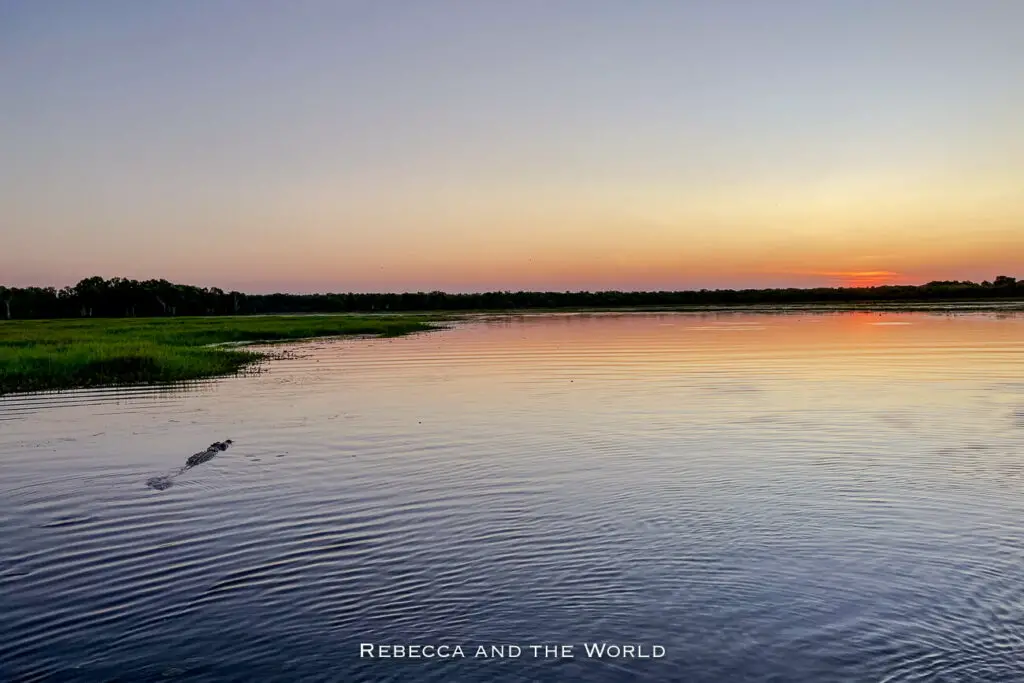
Head south from Darwin to Kakadu National Park, Australia’s second-largest national park. It’s an easy 151km drive (1 hour and 45 mins) on the sealed Arnhem Highway.
Kakadu National Park is usually top of many Australia bucket list experiences, with cultural sites, wildlife, flora, fauna and scenery unlike anywhere else in Australia – or even on Earth.
This park is HUGE – a third of the size of Tasmania! – so you need at least 3 days to see it properly, although you could easily spend a week here.
There are many things to do in Kakadu National Park that it can be overwhelming, so here’s how I recommend spending a few days.
You’ll need a Kakadu National Park Pass to enter the park. You can buy it online or from the visitor centre. A 7-day pass costs $40 for adults and $20 for kids, although they are cheaper in the wet season. Note that your NT Parks Pass won’t get you access to Kakadu, so you’ll need to buy both for this Top End road trip.
Kakadu day 1
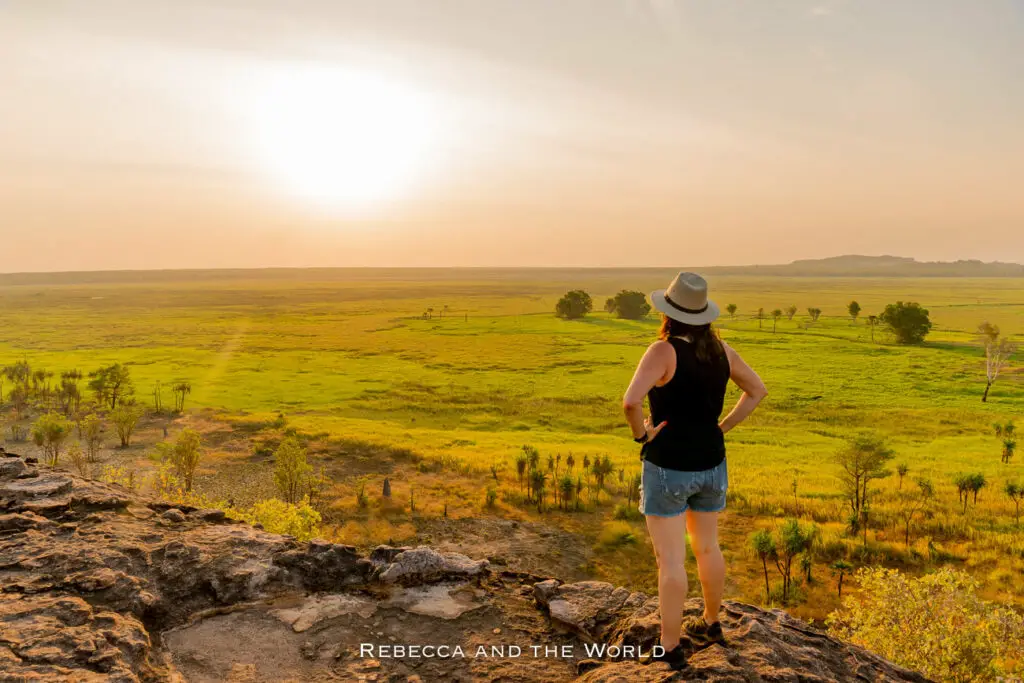
When you arrive in Kakadu, stop by the Bowali Visitor Centre to pick up a Kakadu Visitor Guide and chat with the rangers. They’ll be able to tell you if any parts of the park are closed or other up-to-date info.
If you haven’t bought your Kakadu National Park Pass online already, you can pick it up here.
Then, head to Cahills Crossing for a chance to spot crocodiles. This crossing is also a great place to fish – although keep an eye on the crocs who won’t mind stealing your catch!
In the evening, catch the sunset at Ubirr. At the top of this rock formation, from the Nadab Lookout, you’ll find incredible views stretching out over the vast Kakadu floodplains all the way to Arnhem Land.
Before you get to the top of Ubirr, however, stop in to see the Aboriginal rock art sites along the trail. The oldest paintings here date back thousands of years.
Where to stay
If you’re not camping, book a room at the Mercure Kakadu Crocodile Hotel or Aurora Kakadu Lodge.
For campers and caravanners, book a site at Aurora Kakadu Lodge or Malabanjbanjdju or Burdulba campgrounds. While Merl campground is the closest to Ubirr, it’s known for having a LOT of mosquitos that won’t make for a pleasant stay.
Kakadu day 2
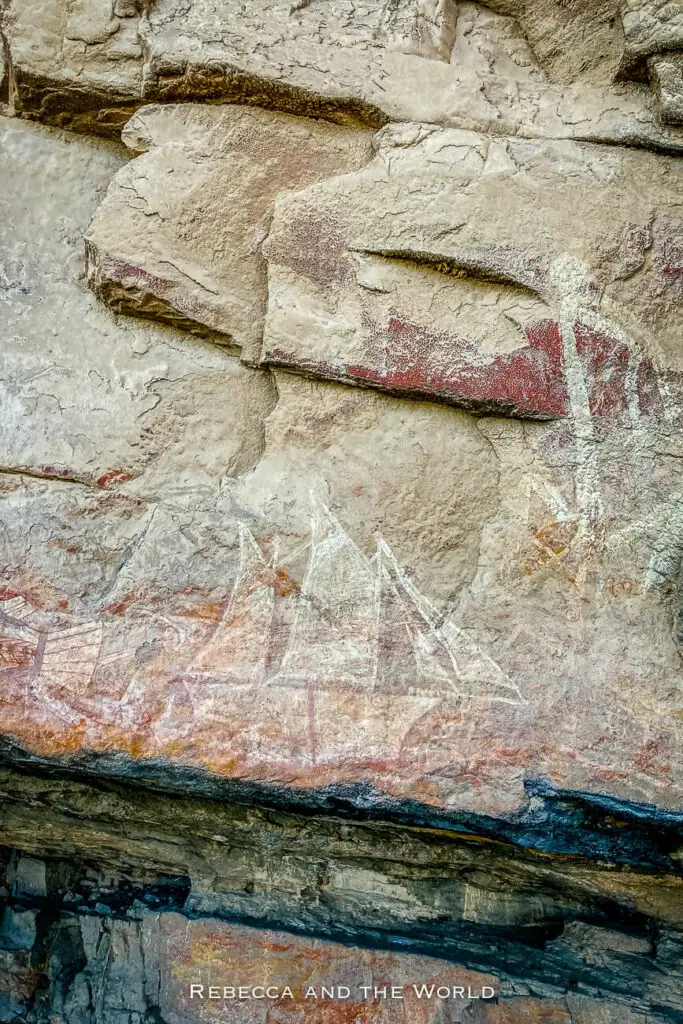
Visit Burrungkuy (Nourlangie) to see ancient rock art and learn about the Indigenous history of this region. Here, you’ll see paintings of people, kangaroos and fish, as well as Namarrkon, the famous Lightning Man. He’s depicted as a grasshopper-like creature who makes the powerful lightning and thunderstorms every summer.
The Nanguluwurr art gallery has even more incredible rock art, including the painting of a masted sailing ship – a representation of early contact between Aboriginal people and Europeans.
There are also handprints and the typical animals in x-ray style, all painted in ochre.
Head up the Nawurlandja Lookout for stunning views or take a stroll around Anbangbang Billabong. The billabong walk is 2.8km easy loop around the billabong, passing through paperbark forest and savanna woodlands.
Take a sunset cruise on Yellow Water Billabong to see the diverse birdlife – and spot plenty of salties!.
Where to stay
Cooinda Lodge has a range of accommodation options, from camping to hotel rooms.
Mardukal campground is a lovely spot with many shady sites, toilets and showers.
Kakadu day 3
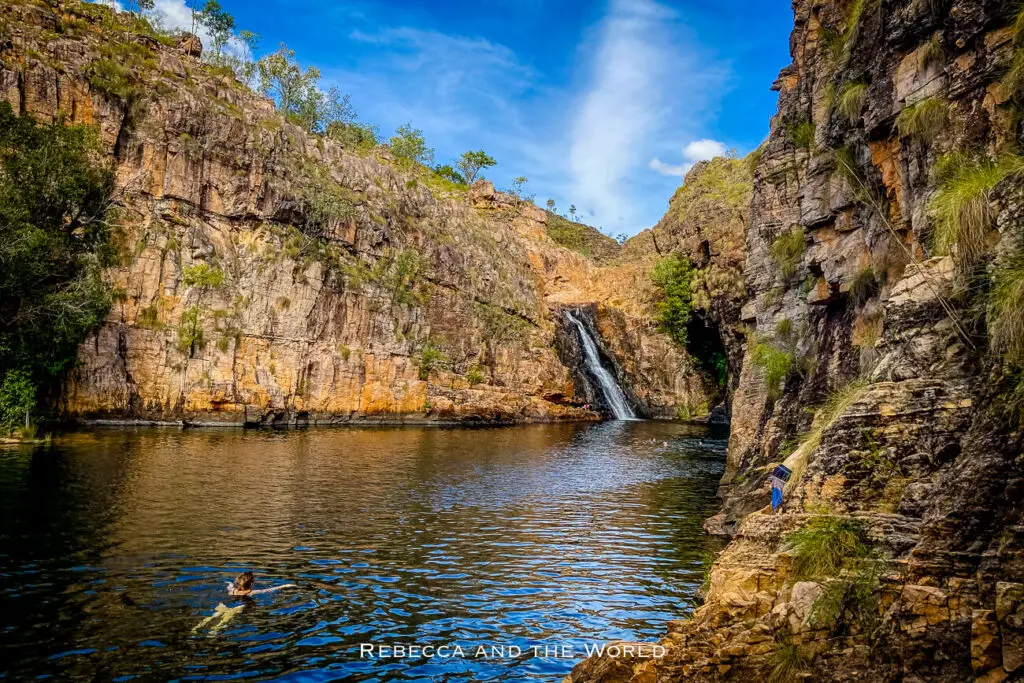
Start your morning with a visit to the Warradjan Cultural Centre to learn about the local Indigenous culture and history. There are informative exhibits on the moiety system, Creation stories, the six different seasons of Kakadu and the wildlife of Kakadu. There are also displays about the arrival of the Balanda (Europeans) and the impact of mining on the park and local people.
End your trip to Kakadu at one of the following swimming holes for a refreshing swim: Maguk, Gunlom (currently closed) or Motor Car Falls.
Where to stay
You’ll have to backtrack to Cooinda Lodge for the night if you’re not camping.
For campers, I recommend the Maguk Campground. Accessible by 4WD (although we did see some 2WD cars), sites are shaded by pandanus and palm trees.
Got more days in Kakadu? Check out my full guide to Kakadu National Park, which includes a 5-day itinerary.
Days 6-7: Kakadu to Katherine
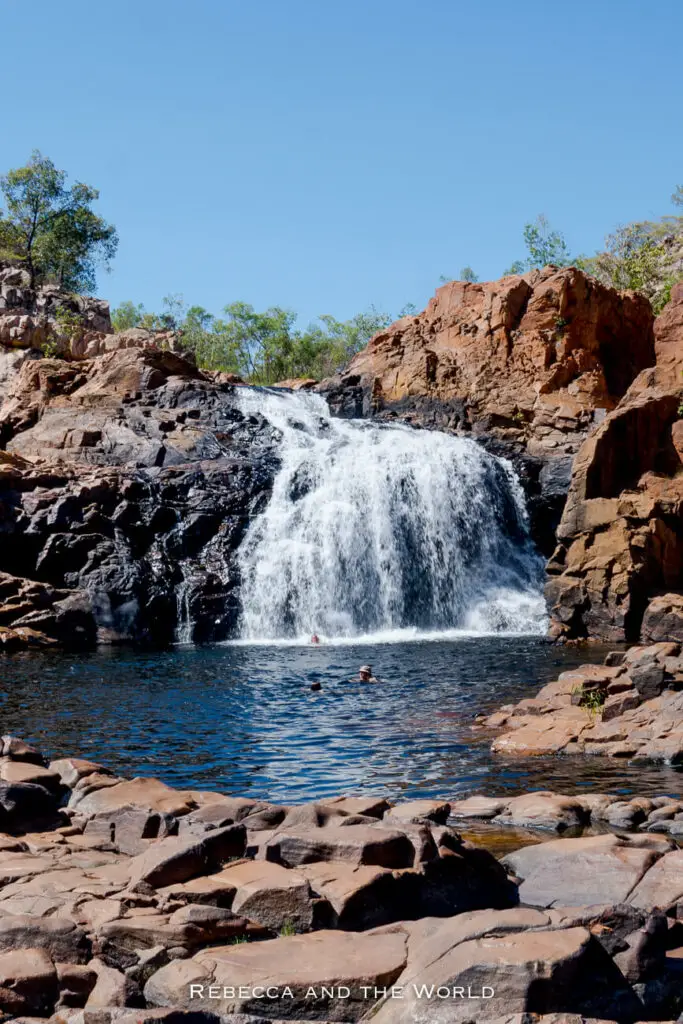
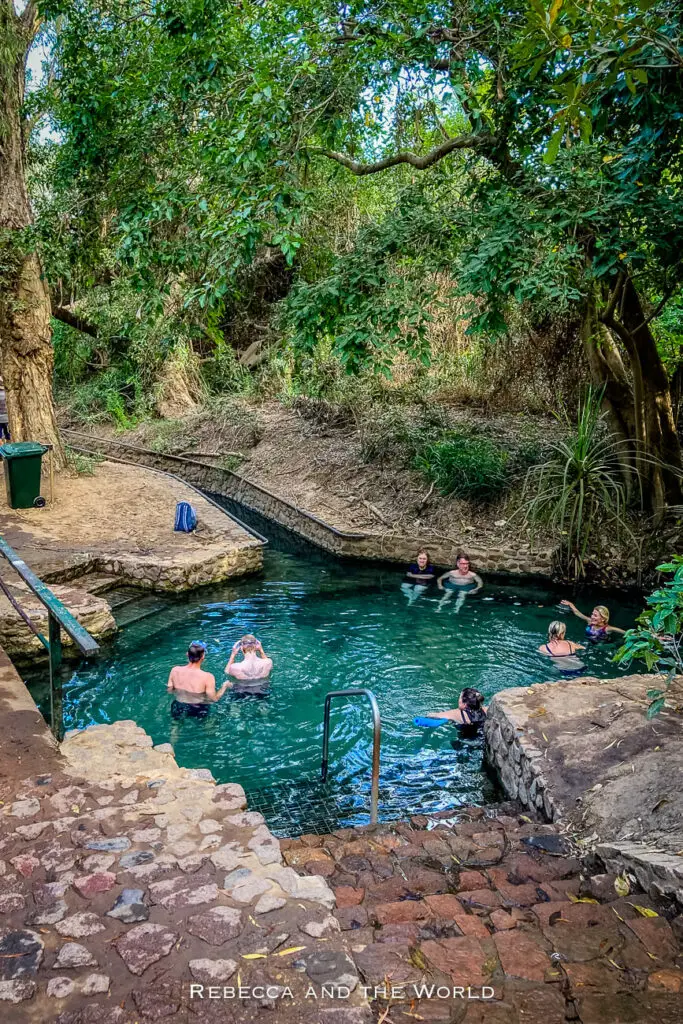
Head further south, about 215km (1.5 hours), to one of my favourite towns in the NT: Katherine.
Right in town, you’ll find Katherine Hot Springs, natural thermal pools that are perfect for a soak and a picnic.
About an hour out of Katherine, in the town of Mataranka, are Bitter Springs and Mataranka Springs, two more beautiful swimming spots.
But the highlight of Katherine is nearby Nitmiluk National Park (Katherine Gorge). This stunning area features a series of 13 sandstone gorges, which you can explore by boat, canoe or on foot – and it’s only 30km from Katherine.
No visitor should miss the short, 1.8km return trail to the Baruwei Lookout. This is where you’ll get the best views over Nitmiluk Gorge.
But if you’ve got a bit more time and energy, try one of the longer Southern Walks. We did the 11.8km Butterfly Gorge trail, which leads to the second gorge. There’s a “beach” at the end of the trail and from here you can jump in for a swim – if you dare!
The second section of Nitmiluk is Leliyn (Edith Falls), about 60km from Katherine. There’s a lot of competition, but I think it’s the most beautiful spot in the NT. This stunning waterfall cascades over multiple tiers into a crystal-clear swimming hole surrounded by lush greenery. Swimming here is one of my favourite things to do in the Northern Territory.
Where to stay in Katherine
We stayed at the Riverview Tourist Village in our camper trailer. We loved it so much that we ended up staying there for more than a week over two different visits! It’s right by the hot springs, so you can be first in when the gates open in the morning. There are cabins and caravan sites. Check rates online.
Other great accommodation options in Katherine are:
- The Contour Hotel, set on four acres of tropical gardens. There are tennis courts, a swimming pool, restaurants, barbecue facilities and a bar. Check rates and availability on Booking.com or Expedia
- Knotts Crossing Resort – Close to the Katherine River, this resort has a range of accommodation options, from cabins to motel-style rooms. It also has a restaurant and swimming pool. Check rates and availability on Booking.com
Don’t want to stay in Katherine? Then you can actually stay right in Nitmiluk National Park. The famous Cicada Lodge is operated by the Jawoyn people and has hotel rooms, cabins and a campground. Check rates and availability on Booking.com or Expedia.
There are also several park-managed campsites in the national park.
Days 8-9: Katherine to Litchfield National Park
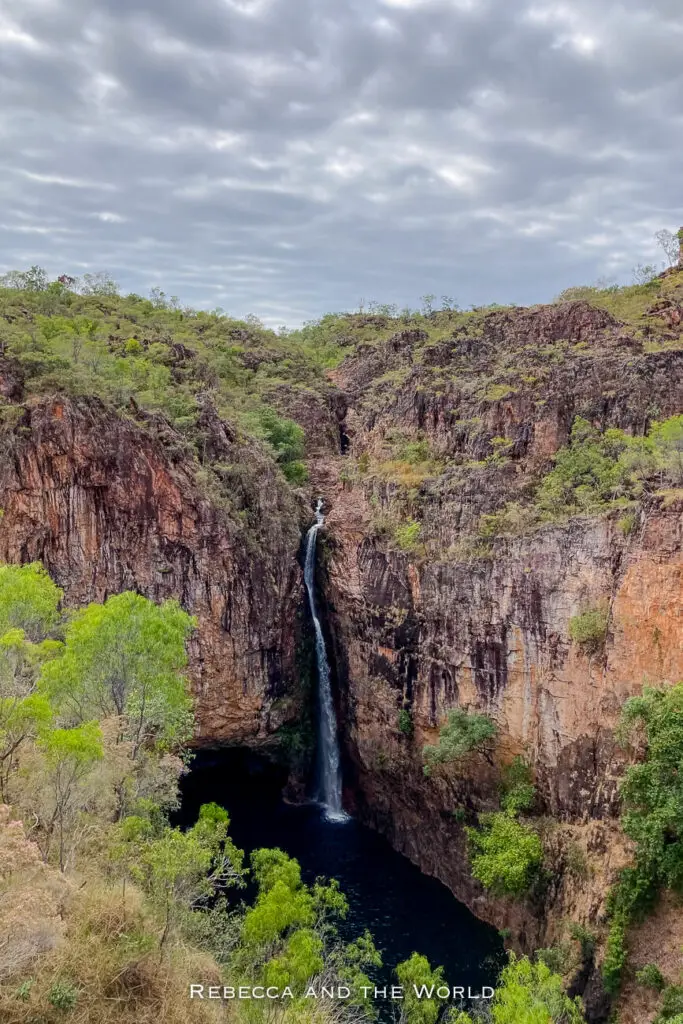
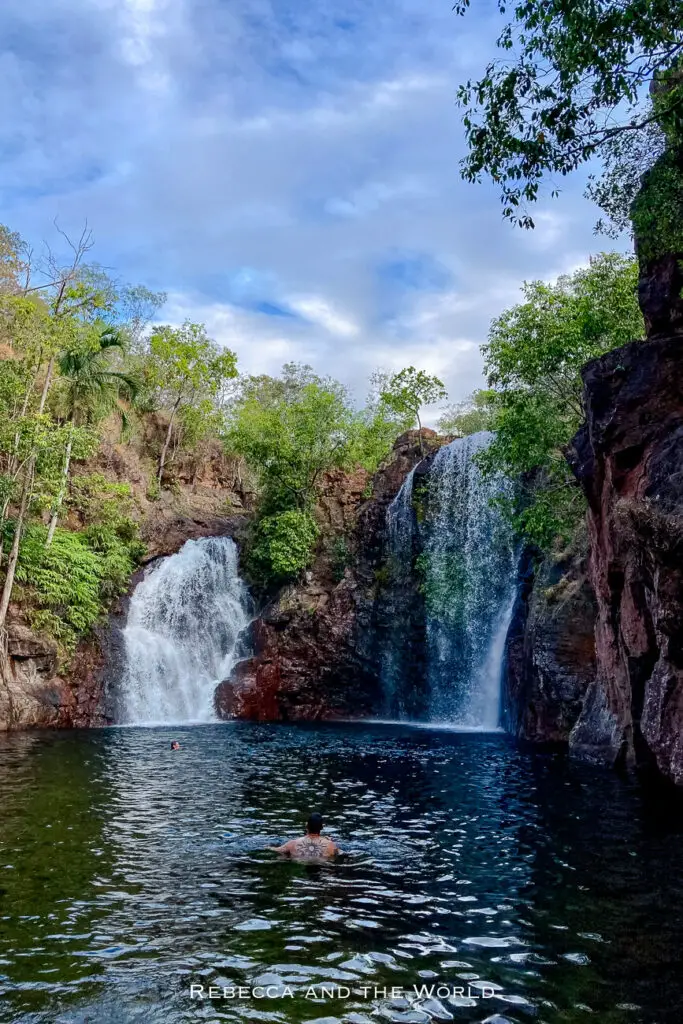
Time to hit the road again, this time returning north to the stunning Litchfield National Park, famous for its swimming holes and waterfalls.
From Katherine, it’s an easy 255km (2.5 hours) up the Stuart Highway.
Litchfield is the highlight of many travellers’ trips to the NT. It’s smaller than Kakadu, but it packs a punch with its natural beauty and refreshing swimming spots.
There’s a lot to see and do in Litchfield National Park, so I recommend spending two days here.
As you enter the park, stop by the Magnetic Termite Mounds, unique structures created by tiny termites that can be as tall as 4 metres.
Next, head to Florence Falls and take the short walk to view the spectacular double waterfall. If it’s busy, leave your car in the same car park and make the short walk to Buley Rockhole to take a dip in the tiered pools.
After a refreshing swim, continue on to Tolmer Falls for more stunning views.
One of the most popular spots in Litchfield National Park is Wangi Falls. The waters here are deliciously refreshing, and you can swim across the swimming hole to the two waterfalls. It feels like you’re in a movie set. There’s also a huge, grassy area by the natural pool that’s perfect for a picnic.
Where to stay in Litchfield National Park
There are several camping areas right within Litchfield National Park. Popular spots include Florence Falls Campground and Wangi Falls Campground – you’ll need to book online in advance to get a spot.
For glamping, Litchfield Safari Camp is in a great location on the western side of the park, about a 10-minute drive from Wangi Falls – so you can be up early to get there before everyone else! Hideaway Litchfield has luxury cabins built from shipping containers, each named after a place in Litchfield.
There are also several caravan parks. We stayed at Litchfield Tourist Park, which has cabins and caravan/campsites. The caravan sites are generously sized and shaded. There are also cabins and even a 3-bedroom homestead for those travelling in a group. There’s a pool and cafe on site. It’s about a 45-minute drive to Wangi Falls from here. Check rates and availability online.
Day 10: Back to Darwin
The drive from Litchfield to Darwin is a short 106km (1 hour 15 mins), so feel free to sleep in and take a leisurely drive back. Or get up early to beat the crowds for a final swim in your favourite Litchfield swimming hole.
On your way back to Darwin, join one of the jumping crocodile cruises on the Adelaide River. It’s a unique experience to see these ancient creatures in their natural habitat, and the tour guides are always full of interesting facts and stories. Just remember to keep your arms and legs inside the boat at all times, eek!
Once you’re back in Darwin, head to the airport for your flight home.
Best time to do this NT road trip
The best time to do this road trip is during the dry season, which runs from May to October. This is when the weather is most pleasant and there is less chance of roads being flooded or closed due to rain.
However, if you don’t mind a bit of heat and humidity, the wet season (November-April) can also offer some unique experiences, such as watching the stunning storms and thundering waterfalls and seeing the lush green landscapes come to life. Check road conditions before setting off on your journey – roads are frequently cut off by flooding.
How to get to Darwin
By air
Flying is the best way to get to Darwin to do this trip. Darwin is connected by air to all the Australian capital cities (except Canberra and Hobart), with daily flights from most of those cities.
You can then rent a car at Darwin International Airport when you arrive.
By car
One of the best ways to reach Darwin – in my opinion – is via the Stuart Highway. The Adelaide to Darwin drive is one of the best road trips in Australia and something everyone should do at least once in their lifetime!
Or you could road trip to Darwin from Broome or from Cairns.
By bus
Greyhound buses travel to Darwin from Alice Springs (21.5 hours), Broome (1 day), Katherine (4.5 hours) and Kununurra (11 hours). When you arrive in Darwin, you can rent a car to do this Northern Territory road trip.
By train
For an epic Australian bucket list experience, take The Ghan all the way from Adelaide to Darwin. This luxury train traverses the Australian Outback for 3 days before arriving in Darwin. Once you arrive, rent a car and hit the road for this NT road trip.
Northern Territory road trip tips
Here are some handy travel tips I picked up along the way while doing this NT road trip.
Get roadside assistance. It’s always a good idea to have roadside assistance in case of any emergencies. This can give you peace of mind when driving long distances and through remote areas.
Stock up on supplies. This road trip includes a lot of time in national parks. You’ll want to stock up on food, water and other supplies in Darwin and Katherine.
Fill up at every opportunity. Fuel stops can be few and far between, especially when you get into the national parks, so fill up whenever you can.
Use an app to check fuel prices. We paid some pretty high prices for diesel in the NT. To save money, we used the PetrolSpy app to compare prices and find the cheapest fuel.
There’s little phone coverage. I was quite surprised at how limited mobile phone coverage was on both the main highways and in the national parks. Telstra is generally better than other networks. However, we rarely had service when inside the national parks.
Get a paper map. It’s hard to get lost on this road trip, but I do always like to have a physical map like this Hema map – especially when the mobile phone coverage is so patchy.
Don’t drive at night. Wildlife is abundant around this area – kangaroos, buffalo and birds. Driving at night greatly increases your chances of hitting an animal. Stick to driving during daylight hours.
Got more time?
If you’ve got more time than 10 days and want to explore the NT further, then go further south. After Katherine, you can continue on to a few different places.
Devils Marbles
A unique and otherworldly landscape of giant granite boulders, the Devils Marbles are a must-see stop on your road trip. Take a walk around these ancient rock formations and marvel at their natural beauty.
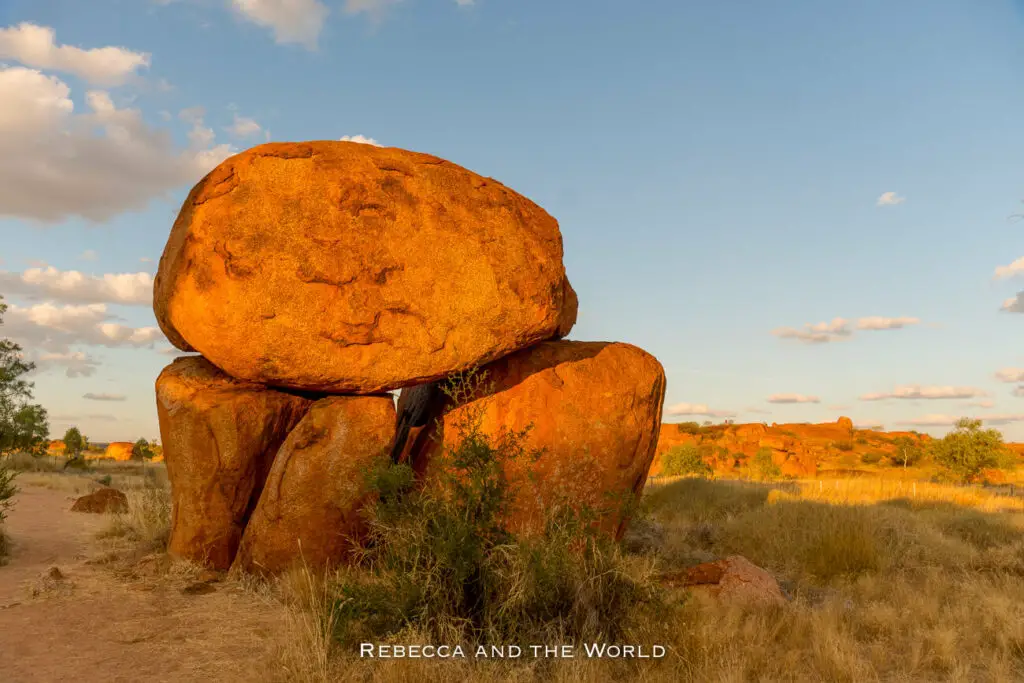
Alice Springs
Known as the gateway to the Red Centre, Alice Springs is a vibrant outback town with plenty to see and do. Visit the Alice Springs Desert Park and learn about the diverse flora and fauna of the area, or learn about Indigenous art at the Araluen Arts Precinct.
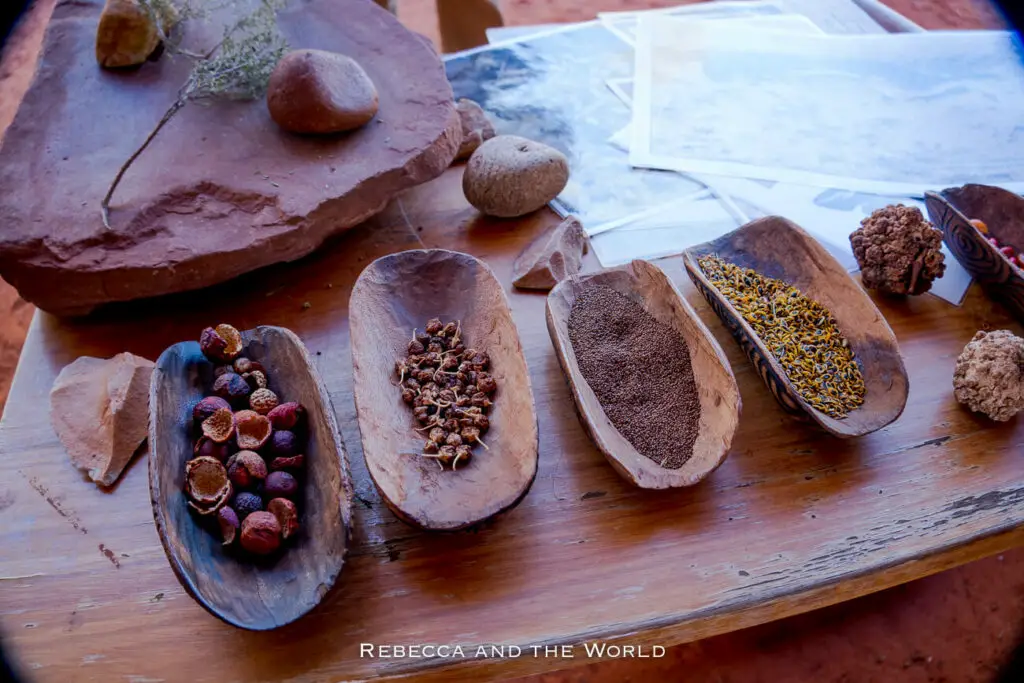
MacDonnell Ranges
The MacDonnell Ranges are a stunning mountain range that stretches for over 600km across the Red Centre of Australia. Take a scenic drive through the ranges and marvel at the spectacular landscapes, or go for a hike through the gorges and waterholes.
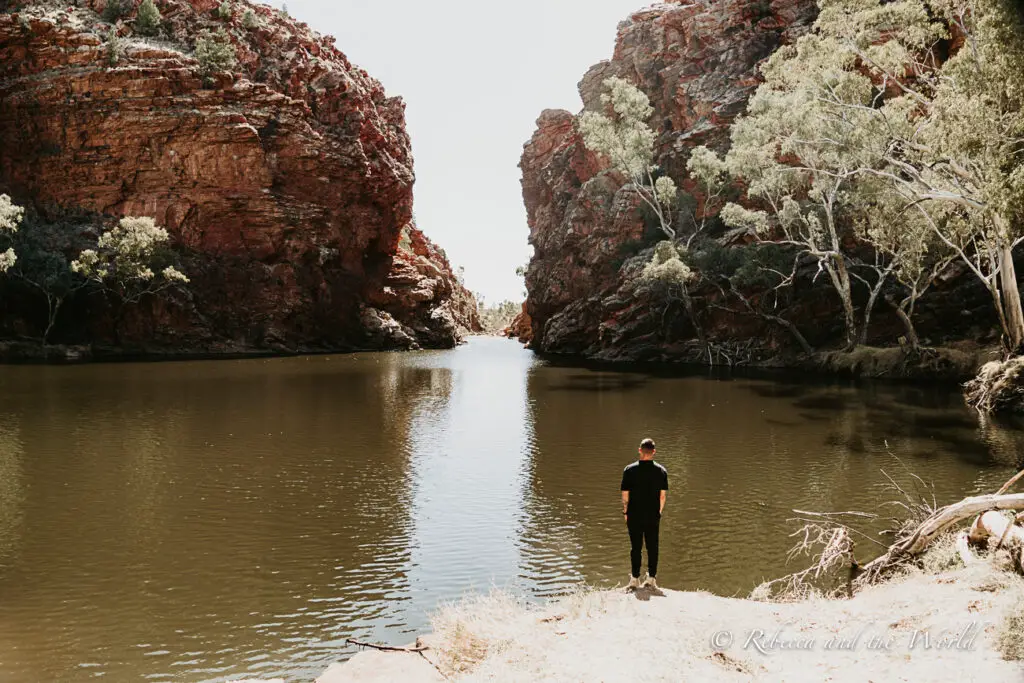
Uluru-Kata Tjuta National Park
No trip to the NT is complete without a visit to Uluru, one of Australia’s most iconic landmarks. Watch the sunset over this sacred monolith, learn about its cultural significance to the traditional owners, and take a guided tour around its base. It’s an experience you’ll never forget.
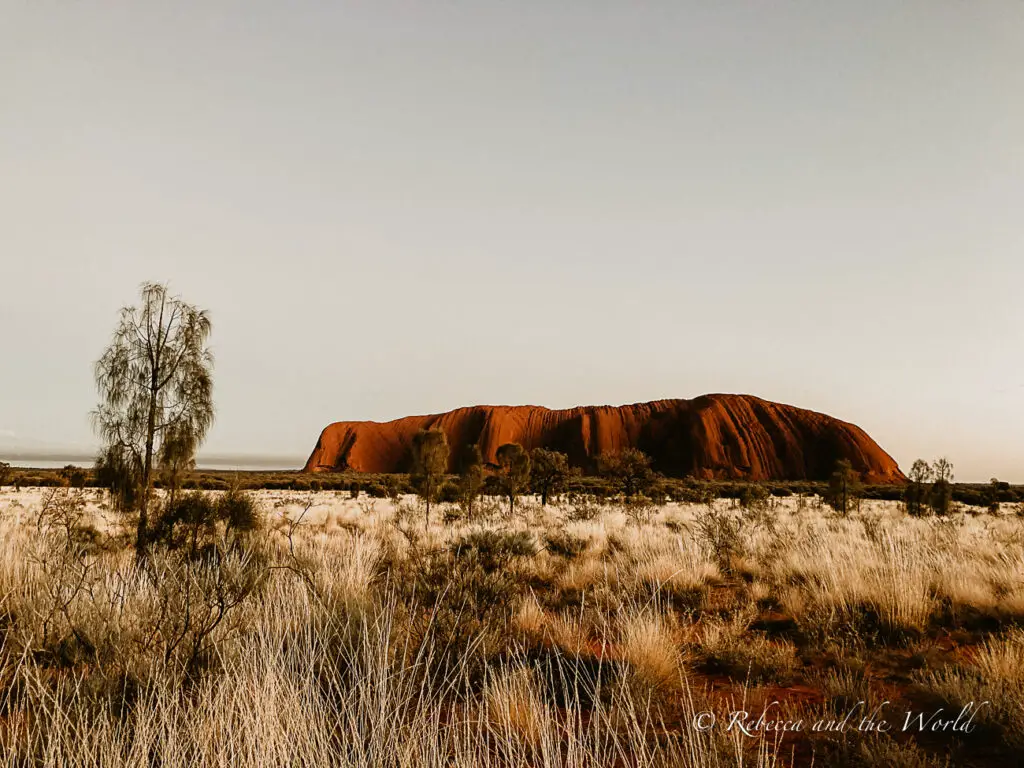
Watarrka National Park/Kings Canyon
Just a short drive from Uluru, you’ll find Watarrka National Park and Kings Canyon. Take a hike through the canyon to see stunning views of the red rock walls and lush oasis below. You can also take a helicopter tour for a bird’s eye view of this breathtaking landscape.
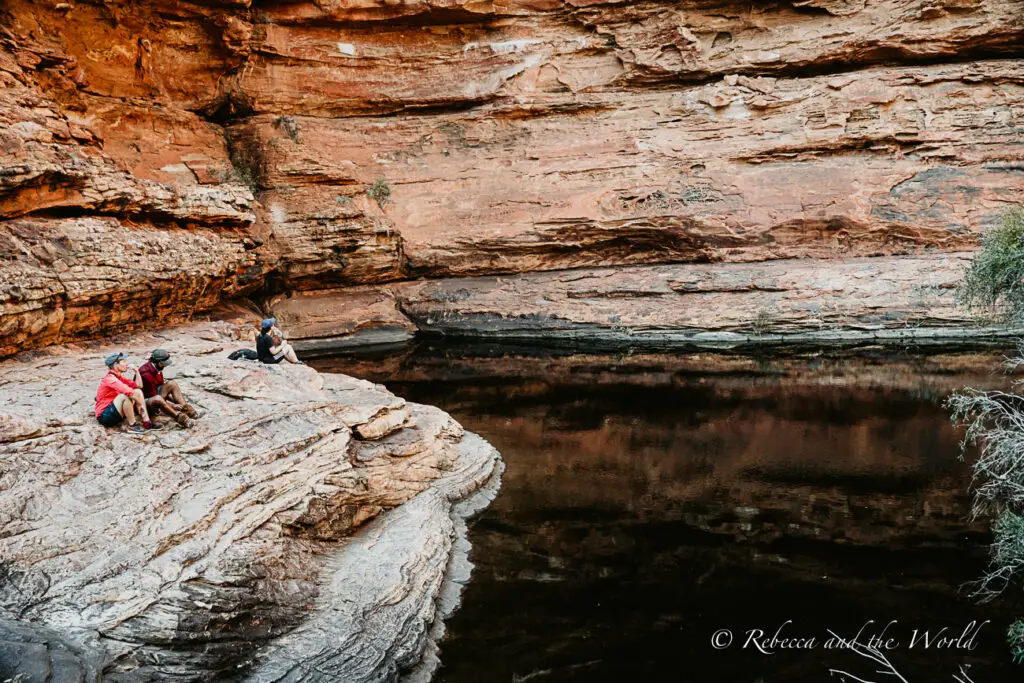
Final thoughts: Top End road trip
I hope this guide has given you a taste of what it’s like to drive through the Top End of the Northern Territory. There’s so much to see and do, and each day will bring rugged landscapes, diverse wildlife and captivating culture. Take your time, stay safe on the roads and enjoy exploring this beautiful part of Australia.
Did you find this article helpful? Consider buying me a coffee as a way to say thanks!
Are you planning a Northern Territory road trip?
Related posts
Before you go… you might like these Australia travel articles:
- How to plan an epic Adelaide to Darwin road trip itinerary
- The best things to do in Darwin
- The best things to do in Katherine, NT
- The best things to do in Nitmiluk National Park
- The ultimate guide to Litchfield National Park
- How to spend a few days in Kakadu National Park
- 19 spectacular things to do at Uluru
- How to spend a few days in Alice Springs
- The ultimate Australia bucket list
AUSTRALIA TRIP ESSENTIALS
- Book your flight to Australia online with Skyscanner. I like this site because it shows me which dates are cheaper.
- Find a great hotel in Australia. Check prices on Booking.com and Expedia online.
- Check out the huge range of day tours throughout Australia on GetYourGuide or Viator. There’s something for everyone.
- A copy of the Lonely Planet guide to Australia will be handy.
- One thing I always purchase is travel insurance! Travel Insurance Master allows you to compare across multiple policy providers, while SafetyWing is great for long-term travellers and digital nomads.
- Pack sunscreen (look for SPF50 or higher), a hat and sunglasses because the sun is hot!
PIN IT FOR LATER: NORTHERN TERRITORY ROAD TRIP ITINERARY
Save this NT road trip to Pinterest so you can plan your epic trip later!
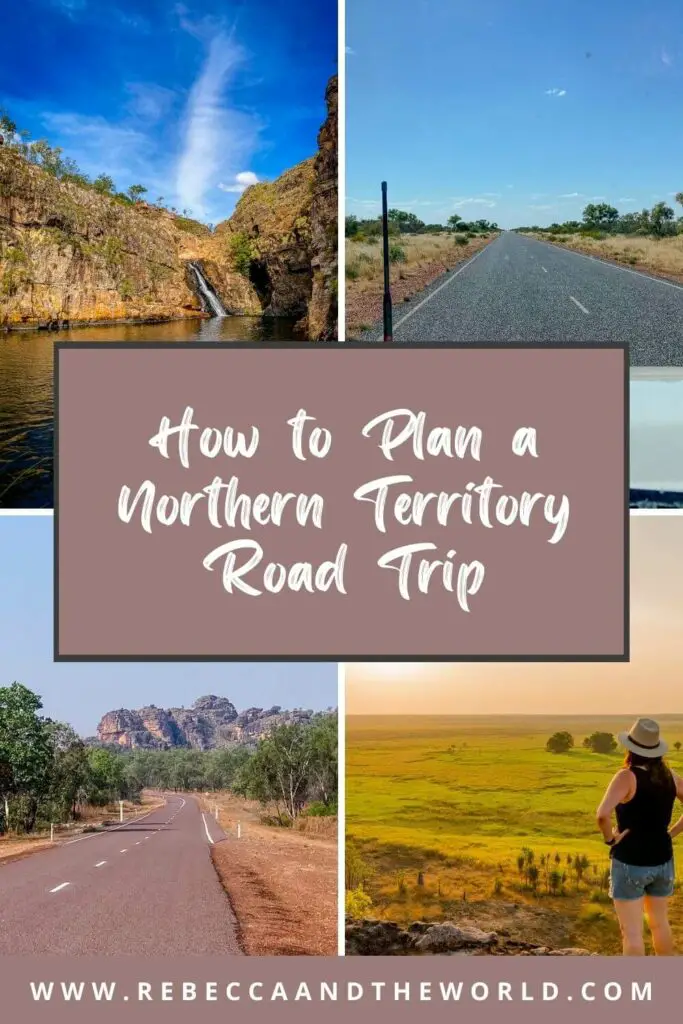
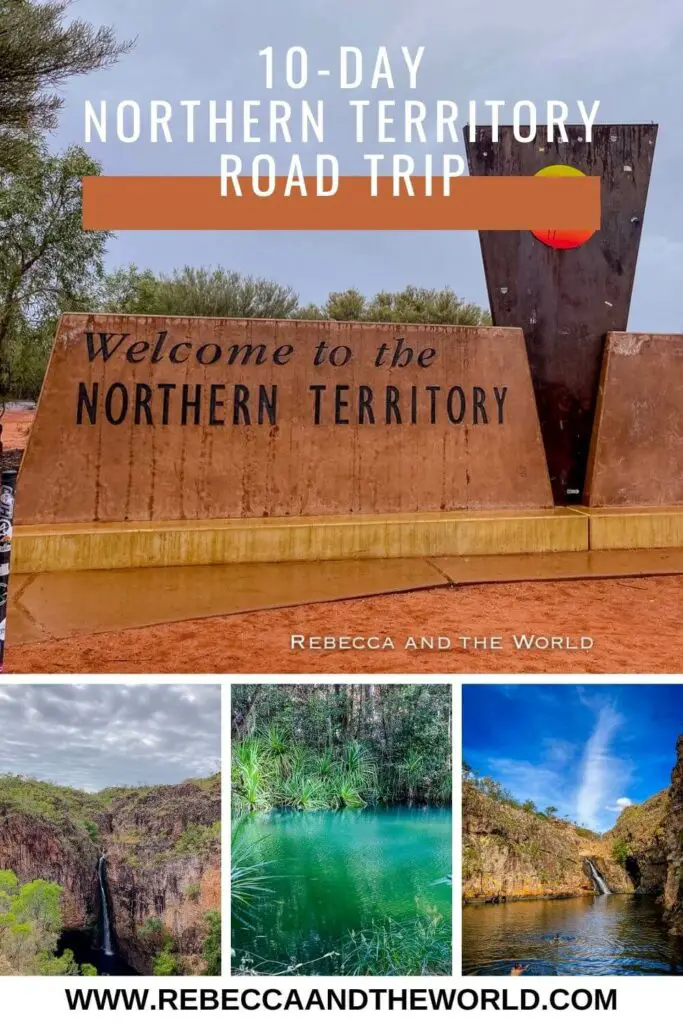



Hi Rebecca,
You’re amazing. Thanks for sharing your travel experiences throughout the Northern Territory with your followers. I have already signed up for your newsletters.. It is choc full of wisdom, wonderful “must see” places and accommodation ideas. This has inspired me to plan my own trip for later in the year.
Warmest wishes.
Thanks Theresa! 🙂